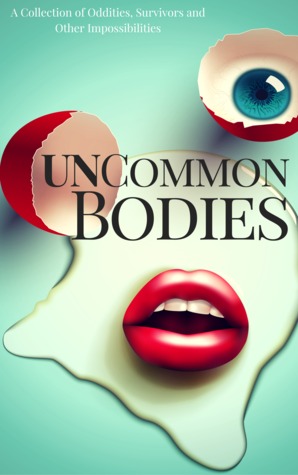UnCommon Bodies presents a collection of 20 beautifully irreverent stories which blend the surreal and the mundane. Together, the authors explore the lives of the odd, the unbelievable, and the impossible. Imagine a world where magic exists, where the physical form has the power to heal or repulse, where a deal with the devil means losing so much more than your soul.
Goodreads Description
One of publishing's necessary evils is the requirement to allot categories to books. Categories are necessary to help buyers find your book, but create a nightmare for authors and publishers of books which aren't obviously in a single genre. This issue is something magic-realist writers complain about constantly. And when it comes to short story collections the problem is well nigh impossible to solve. This is very much the case with UnCommon Bodies. Although the collection has been riding high in Amazon's magic-realism category, many of the stories are not magic realism to my thinking. I suppose if pressed I might describe the collection as slipstream, but then would immediately add provisos. What the stories have in common is that their subjects have something unusual about their bodies - sometimes natural (scars, Siamese twins), sometimes magical, fantastical or scientifically modified.
You get a lot in this collection - not only 20 stories but sci-fi, LGBT, erotica, horror, poetry, psychological fiction and yes magic realism. Some stories of course belong to several genres at once.
With so many stories to choose from I will focus on my favourites.
In Her Image by Vasil Tuchkov.
Mythic fiction/magic realism. An English PhD student researching an elusive mythical woman meets with a crippled Italian painter who claims to have caught the likeness of the woman at great cost. An eerie tale.
UnTamed by Laxmi Hariharan.
An Indian take on the werewolf story, complete with mythic and spiritual references.
From the Inside by Daniel Arthur Smith.
Set in my beloved Central Europe (indeed in my local town of Cesky Krumlov) this is another tale of a search for an artist - this time a Hungarian tattooist with a secret.
Daedalus' Daughter by P.K. Tyler.
A daughter mourning the loss of her family begins to sprout feathers. She returns to the lakeside family cabin where her brother was killed and the transformation continues.
Scars: First Session by Jordanne Fuller.
Not magic realism or indeed speculative fiction. Instead it is a moving account of how a young woman confronts the abuse that covered her body with scars as a tattooist transforms each scar into something beautiful.
Mythic fiction/magic realism. An English PhD student researching an elusive mythical woman meets with a crippled Italian painter who claims to have caught the likeness of the woman at great cost. An eerie tale.
UnTamed by Laxmi Hariharan.
An Indian take on the werewolf story, complete with mythic and spiritual references.
From the Inside by Daniel Arthur Smith.
Set in my beloved Central Europe (indeed in my local town of Cesky Krumlov) this is another tale of a search for an artist - this time a Hungarian tattooist with a secret.
Daedalus' Daughter by P.K. Tyler.
A daughter mourning the loss of her family begins to sprout feathers. She returns to the lakeside family cabin where her brother was killed and the transformation continues.
Scars: First Session by Jordanne Fuller.
Not magic realism or indeed speculative fiction. Instead it is a moving account of how a young woman confronts the abuse that covered her body with scars as a tattooist transforms each scar into something beautiful.
But your favourites will probably be different from mine. All the stories are good, although some are a bit too in-your-face for me.
I received this book from one of the authors in return for a fair review.



